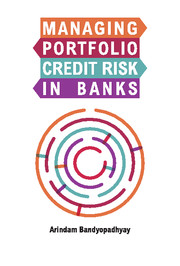Book contents
- Frontmatter
- Dedication
- Contents
- Tables, Figures, Charts
- Preface
- Acknowledgements
- Abbreviations
- 1 Introduction to Credit Risk
- 2 Credit Rating Models
- 3 Approaches for Measuring Probability of Default (PD)
- 4 Exposure at Default (EAD) and Loss Given Default (LGD)
- 5 Validation and Stress Testing of Credit Risk Models
- 6 Portfolio Assessment of Credit Risk: Default Correlation, Asset Correlation and Loss Estimation
- 7 Economic Capital and RAROC
- 8 Basel II IRB Approach of Measuring Credit Risk Regulatory Capital
- Index
Preface
Published online by Cambridge University Press: 05 May 2016
- Frontmatter
- Dedication
- Contents
- Tables, Figures, Charts
- Preface
- Acknowledgements
- Abbreviations
- 1 Introduction to Credit Risk
- 2 Credit Rating Models
- 3 Approaches for Measuring Probability of Default (PD)
- 4 Exposure at Default (EAD) and Loss Given Default (LGD)
- 5 Validation and Stress Testing of Credit Risk Models
- 6 Portfolio Assessment of Credit Risk: Default Correlation, Asset Correlation and Loss Estimation
- 7 Economic Capital and RAROC
- 8 Basel II IRB Approach of Measuring Credit Risk Regulatory Capital
- Index
Summary
Effective credit risk management has gained an increased focus of banks in India in recent years, mainly driven by the changing regulatory regime in line with Basel II advanced internal rating-based (IRB) approaches as well as Basel III. Regulatory capital standards based on internal credit risk models would allow banks and supervisors to take advantage of the benefits of advanced risk-modelling techniques in setting capital standards for credit risk. Banks in India should now have a keen awareness of the need to identify, measure, monitor and control credit risk as well as to determine that they hold adequate capital against these risks and that they are adequately compensated for risks incurred to survive during the downtime. In this light, this book provides a basic guide to understand various modelling requirements, and then focuses on the role these models and techniques have in measuring and managing credit risk under the advanced IRB approach which may be adopted by Indian banks.
Credit risk models are the tools that assist banks in quantifying, aggregating and managing risk across geographical and product lines. The outputs of these models also play increasingly important role in enhancing banks' risk management and performance measurement processes through customer profitability analysis, risk-based pricing, active portfolio management and crucial capital structure decisions. Credit risk models enable banks to assess internally the level of economic capital to be allocated to individual credit assets and the credit portfolio as a whole. And most importantly, validated credit risk models and their proper use tests are the basic building blocks to achieve regulatory compliance. An efficient management of credit risk is a critical component of a comprehensive approach to risk management and essential to the long-term success of any banking organization.
This book is an attempt to demystify various standard mathematical and statistical models that have been widely used by globally best practiced banks and demonstrates their relevance in measuring and managing credit risk in emerging Indian market. The book would help the academicians/ practitioners/risk managers/top executives in banks as well as students in the banking and finance area to understand the nuances of credit risk management that involves understanding modern tools and techniques in identifying, evaluating credit risk and its implications on profits and business strategies.
- Type
- Chapter
- Information
- Managing Portfolio Credit Risk in Banks , pp. xv - xixPublisher: Cambridge University PressPrint publication year: 2016

